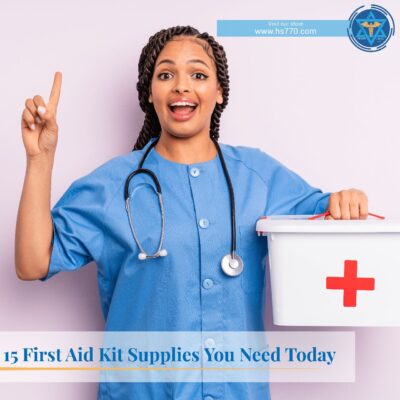Injuries and illnesses happen suddenly and without warning. That’s why it’s essential to be prepared for anything by having a first-aid kit. But what should you include these medical supplies in your first-aid kit?
While the contents of a first-aid kit will vary depending on the individual’s needs, there is specific medical equipment that everyone should have. For example, all first-aid kits should include bandages, gauze, and tape.
Today, we will provide a list of 15 first-aid kit supplies you need. We will also explain why each item is essential and how it can be used in a variety of different situations.
What are the 15 First Aid Kit Supplies You Need?

1. Tweezer
Tweezers are “small equipment used for picking up things that are too small to be handled properly with human fingers.” A tweezer comprises two levers that are joined at one end and have pincers at the other. To make the pincers grab an item, you squeeze the levers together. Tweezers are operated with one hand since they are so small.
Tweezers are a must-have item in every first-aid kit, especially if you like hiking or other outdoor sports. A clean pair of tweezers is the safest technique to remove a splinter or a tick. Before and after each usage, properly clean the tweezers with alcohol.
2. Adhesive Bandages
Adhesive bandages are helpful in treating minor wounds, scratches, and blisters. They come in various forms and sizes to fit various injuries, so equip your pack with as much diversity as possible. Include butterfly-shaped bandages, which may be used to close two sides of a wound. You could also want impermeable bandages or bandages with antibacterial medicine.
You might also include a liquid bandage, which is a waterproof adhesive that only has to be applied once and may hasten recovery. Adhesive bandages are used more frequently than bigger and smaller bandages; consider including a few extras in your first aid kit to avoid shortages.
3. Cleansers and Antiseptics
Antiseptic wipes such as benzalkonium chloride (BZK) and alcohol should be kept in every first aid kit or cabinet for cleansing and sterilizing wounds and tools used in wound treatment. Hand sanitizers are also recommended by modern thinking to disinfect the rescuer before and after first aid treatment.
4. Disposable Gloves
Gloves are essential for protecting the person providing first aid and keeping a wound free of germs and other hazardous organisms. They may also be used to wipe up areas where blood or other body fluids have been spilled.
Personal protection equipment must be included in a workplace or individual first aid kit for the safety of the rescuer and the comfort of the casualty. To protect latex-sensitive users, gloves should always be latex-free.
5. First Aid Guide
A first aid manual will provide you with step-by-step instructions for treating wounds, sprains, bites, and other common problems. It is critical that everyone who has access to the kit reads the handbook before a crisis happens to ensure that any injuries are correctly treated.
6. Instant Cold Pack
Icing an injury has several advantages. After a fracture or accident, the cold can reduce blood flow, reducing swelling and bruising. The cold can also relieve irritation from stings and bites.
An immediate cold pack that turns frozen when material within is triggered (often by shaking or twisting the ice pack) is a must-have in your first-aid kit. Because immediate cold packs can only be used once, have several in your equipment.
7. First Aid Scissors
Scissors are a must-have item in every first-aid kit. They can be used to cut bandages, dressings, and tape to size, cut through wounded people’s garments to reach a wound, or assist in removing dressings so bandages can be replaced. In an emergency, scissors can also be used to cut through seatbelts or other complex materials.
8. Medical tape and sterile gauze pads
Medical gauze that has been sterilized to prevent bacteria from entering an open wound should always be included in a first-aid kit. To stop bleeding or cover a wound that is too large for an adhesive bandage, use a length of gauze or pre-cut gauze pads. Clean the wound first, then apply gauze and tape to hold it in place.
9. Hand Sanitizer
Germs found anywhere! They can get onto our hands and the things we touch in our daily lives and make us sick. Cleaning your hands with soap and water or a hand sanitizer containing at least 60% alcohol at critical times is one of the most important precautions you can take to avoid getting sick and transmitting germs to people around you. Hand sanitizers also may fail to eliminate hazardous substances such as insecticides and heavy metals such as lead.
10. Pain Relievers
No first aid kit would be complete without pain relievers and fever reducers. Over-the-counter pain medications include aspirin, acetaminophen, and ibuprofen. Because of the risk of Reye’s syndrome, aspirin should not be administered to anybody under the age of 18. These medications give treatment for a variety of mild aches, pains, and diseases.
11. Antibiotic Ointment
There are several topical antibacterial drugs available, such as bacitracin, neomycin, and polymyxin. Some brand-name drugs, such as Neosporin and Mycitracin, combine all three treatments into a single formulation.
Before covering a wound, apply antibiotic ointments directly to it or to an adhesive bandage or gauze pad. These formulations can aid in the prevention of bacterial development, which can lead to illness and poor recovery.
12. Thermometer
Temperature is one of your body’s critical signals, and a substantial fluctuation in temperature may suggest disease or the need for rapid medical assistance. Using thermometers is the most accurate technique to monitor your temperature.
A basic digital oral thermometer is a space-saving solution for a first-aid kit for testing to determine if a kid has a fever caused by a sickness or infection. Glass thermometers should be avoided since they can break.
13. Kit for Tooth Preservation
To have the best chance of taking root in a child’s mouth, a knocked-out permanent tooth should be replanted by a dentist as quickly as possible—ideally, within 15 minutes. Older children who can hold a dislodged tooth in place with gauze while they seek emergency medical attention should do so. However, if you have small children, a tooth preservation kit may be the best option.
Tooth preservation kits include a saline solution that is great for preserving a dislodged tooth before visiting the dentist.
14. Gauze Bandages
Adhesive bandages may not be large enough to cover a wound in some instances. That is why it is critical to have gauze bandages in your first aid kit that may be used to absorb blood. Because gauze bandages come in a variety of sizes, make sure your first aid box contains a variety of sizes.
15. Cough and Cold Medications
Cough and cold Medications can help alleviate the symptoms of a common cold. A sore throat, stuffy or runny nose, sneezing, and coughing are all signs of a cold. A cold or the cough that it generates is typically not treated. A cold cannot be cured, and medicines will not help you recover.
Other Emergency Supplies to Have in Your First Aid Kit
You haven’t finished packing your first-aid kit items yet. Add the following things to ensure you have all you need in one location.
Include all emergency medical help numbers. Make a note of all the phone numbers for each member of your family and their physicians. Have the numbers for local emergency agencies, including your emergency road service provider, on hand.
You should also include any medical history forms and medical consent forms for each family member in your kit. Keep the originals in a secure location, but have duplicates on hand in case of an emergency.
Keep your first aid kit fully stocked at all times with a wider range of medical emergencies and buy medical supplies online from Health Supply 770.
FAQs
What is in the first aid kit box?
The first aid kit contains bandages, safety pins, eye wash, gauze, gloves, eye wash packets, alcohol wipes, and tri-fold plastic bags.
What are the types of first aid kits?
There are two types of first aid kits: Class A and Class B. Moreover, many first aid kits do not fit into these categories due to the number of materials or their intended usage.
What is emergency first aid?
Emergency First Aid is the emergency treatment of severe bleeding, severe shock, heart attack, and stroke.
What are the golden rules for first aid?
- In all medical situations, use a methodical strategy.
- Identify and prevent dangers to yourself, the affected individual, and third parties.
- Early assistance should be requested.
- Be “suspicious,” and presume it’s something serious.
What is the complete form of first aid?
First Investigation Relief Symptom Treatment Arrangement Immediately Disposal.

PhD Scholar (Pharmaceutics), MPhil (Pharmaceutics), Pharm D, B. Sc.
Uzma Zafar is a dedicated and highly motivated pharmaceutical professional currently pursuing her PhD in Pharmaceutics at the Punjab University College of Pharmacy, University of the Punjab. With a comprehensive academic and research background, Uzma has consistently excelled in her studies, securing first division throughout her educational journey.
Uzma’s passion for the pharmaceutical field is evident from her active engagement during her Doctor of Pharmacy (Pharm.D) program, where she not only mastered industrial techniques and clinical case studies but also delved into marketing strategies and management skills.
Throughout her career, Uzma has actively contributed to the pharmaceutical sciences, with specific research on suspension formulation and Hepatitis C risk factors and side effects. Additionally, Uzma has lent her expertise to review and fact-check articles for the Health Supply 770 blog, ensuring the accuracy and reliability of the information presented.
As she continues her PhD, expected to complete in 2025, Uzma is eager to contribute further to the field by combining her deep knowledge of pharmaceutics with real-world applications to meet global professional standards and challenges.








